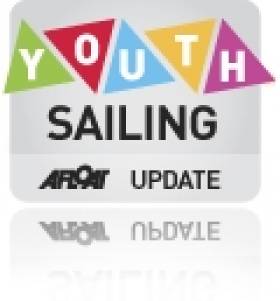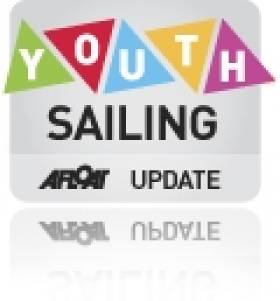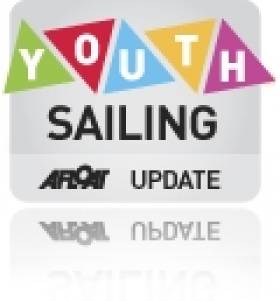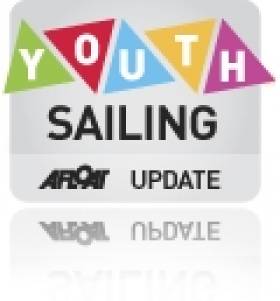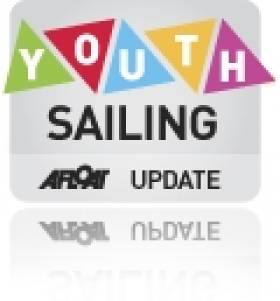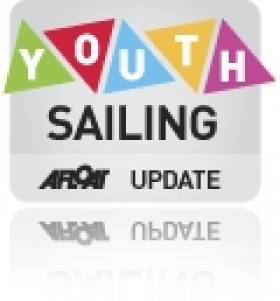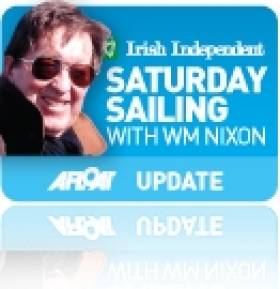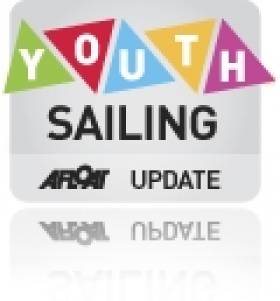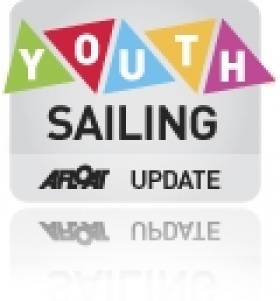Displaying items by tag: Student Yachting World Cup
Trinity & UCD Contest Student Yachting World Cup
Two Dublin University Sailing teams are competing in this week's 35th edition of the Student Yachting World Cup (SYWoC) that began in France today. Both Dublin University (Trinity) and UCD Sailing Clubs return to France for the highlight of the Student sailing calendar. UCD return for the fourth time in a row and as previous winners from 2012. Trinity earned the invite to La Baule – Le Pouliguen in recognition of its 'consistent performance at Student Yachting Nationals' as well as being 2006 Cup holders.
This year’s event will be sailed using J80’s and involves a coastal leg along with the scheduled inshore races.
Up to 20 teams are taking part including the University of Southampton (England), the Ecole polytechnique fédérale de Lausanne (Switzerland), and the University of Brescia (Italy).
The event has been taking place since 1979 and is seen as the most prestigious keelboat competition in the student sailing calendar.
The UCD team for this year consists of Ryan Glynn (Skipper), Ronan Jones, Colin O’Mahoney, Cliodhna Conolly, Cian Cahill and Emma Reidy.
Ireland Place Fourth In Student Yachting World Cup
#sywoc – The UCD Sailing Team, led by Philip Doran, has placed fourth overall for Ireland in the annual Student Yachting Worlds which concluded on Wednesday night at La Rochelle on France's Biscay coast. In a highly pressurized and very international event which Ireland has twice won overall within the past decade, it was the third year in a row that UCD had won the right to sail as the national team as a result of victory in the selection series back in the spring.
Since then, the squad of Philip Doran (helm), Rory Lynch (tactics & mainsheet), Ben Fusco (trim), Sophie Murphy (trim) Tara Flood (pit), Cian Mollen (mast) and Will Byrne (bow), with Vinnie Varley and Hannah Levins as subs, have been in intensive training afloat and ashore as it could best be fitted into their own busy summer sailing programmes, and as well they were brought to a peak of fitness in UCD's High Performance Gym.
The event itself was raced in Grand Surprise performance keelboats, and sailing conditions covered just about all the options for an international field of 12 nations, the most-travelled being Canada, the USA and Japan. From the outset, the English team helmed by Annabel Vose was putting in a prodigious performance whatever the kind of race and course being set, and their final scoreline of 1,2,1,1,1,1,2,1, 2,5,5,3,1,1,1,2 pretty well sums up the progress of the event.
At one stage Ireland was looking good for third overall, but an OCS put paid to that, with Norway slipping into the remaining podium position by just one point.
Two IRL international judges were on the Jury for the event - Tony O'Gorman and Gordon Davies (chairman)
STUDENT YACHTING WORLDS 2014
1st England (helm Annabel Vose) 30pts; 2nd Italy (Luca Nassini) 76pts; 3rd Norway (Ida Trulsrud) 87pts; 4th Ireland (Philip Doran 88pts; 5th Switzerland (Ireneu Pla) 89pts; 6th USA (Dillon Lancaster) 93pts.
UCD Sailing Team Return To Student Yachting Worlds 2014
#sywoc – UCD will return to the Student Yachting World Championships next month to represent Ireland for the third year in row and as previous winners in 2012. UCD launches its team for the 34th Student Yachting World Cup this coming Saturday, October 4th. The event will be held in the Royal Irish Yacht Club, Dun Laoghaire at 5pm. The team and its sponsors will be announced.
The SYWoC (Student Yachting World Cup) is an event organized every year in France by students for students. The event has been taking place since 1979 and is seen as the most prestigious keelboat competition in the student sailing calendar.
This year's event is being held in La Rochelle from October 15th-22nd. The championship will be sailed using Grand Surprise 32s designed by Joubert-Nivelt. UCD Team Ireland will travel with high aspirations having won the event in 2012 at the same venue.
Fifteen teams from as far as China, Australia and the USA are expected to compete and represent their universities and nations. The sailing crew will be composed of a minimum of 6 members and a maximum of 8 members with at least 2 women and two men on board.
Student Yachting Title for France, Ireland Finish Eighth & Ninth
#sywoc – France won the 2013 Student Yachting World Cup in style on home waters at the weekend leaving the Irish defending champions, UCD in eighth. A second Dublin universities team was ninth in the 14–boat fleet. Details from Michalis Pateniotis:
This morning, we could see tired faces among every crew. Today was the last day of the 33rd edition of the Student Yachting World Cup. France was already known, yesterday, as the new champion. Switzerland, second, was 6 points ahead Team USA. The EPFL team must secure their place.
Today, because of the tide, only one race could happen. The committee chose a windward leeward race. This race runs for the "Pornic Trophy".
The wind was very low, with only 7 knots coming from South East. All the teams did a fair start. This race was without spinnakers. France finished this race sixth, enough to secure overall victory.
Back to the harbor, France from Kedge Business School celebrated their victory on the pontoon after 18 outstanding races on the water. The AGPM trophy for the general winner of the coastal races also belongs to France. The trophy of the city of Pornic belongs to Switzerland, winner of the race of the day and also second at the general ranking. The USA finished third and complete the podium.
Irish Youth Teams Eighth & Ninth at Student Yachting World Cup
#sywoc – Irish sailing teams lie eighth and ninth after the fourth day of racing at the Student Yachting World Cup in France. The Swiss team had an outstanding performance to be in second place but it is still the French hosts from Kedge BS that keep the lead in Ponic.
The 14 schools raced J/80s in four windward-leeward races. UCD are eighth and an Irish Universities team is ninth. Results here
#sywoc – UCD launched the defence of its Student Yachting world Cup (SYWC) title last night at the Royal Irish Yacht Club in Dun Laoghaire, revealing Laser dinghy ace Philip Doran from Wexford as its helmsman. It also announced there will be material changes to the format of the competition that starts next Thursday in La Rochelle, France.
The internatinoal college competition is now using J80 sportsboats instead of the larger A35 which means only half the crew number are required.
There is a also a significant change to the UCD crew line up, only two of the last years champions remain, the rest of the 2012 winning team has graduated.
Belia Morehead, Ben Fusco, Sophie Murphy and Conor Murphy and UCD Sailing Club commodore Vinnie Varley complete the crew line up.
#sywoc – University of Limerick, with Rob O'Leary as helm, have continued their winning ways into keelboats, emerging as clear winners of the trials to select Ireland's national representatives for the Student Yachting Worlds 2013 to be staged in France in late October writes WM Nixon.
UL have been on a run of success this year, as their team racers – captained by Ross Murray – won the national intervarsity opens from 26 teams in Fireflies at Tralee Bay five weeks ago. But the selection for the squad to go to the Worlds takes a different path, as it's fleet-raced in the ISA SailFleet J/80s, which will also be boat used this year at the Worlds.
The Irish selection trials were notably comprehensive, as they have been sailed in Howth over three Saturdays – April 6th, 13th and 20th. Despite April's unseasonably wintry weather, as the university racing was incorporated with the Howth YC Spring Warmer series, each day's racing got under way early. So though on two of the days conditions were to deteriorate to a gale before nightfall, the full programme was successfully completed.
Rob O'Leary and his crew started well, and were remarkably consistent. In a six race series with no discards, they notched a 1st and 2nd on all three days. As the final day's racing came up with a bit of Spring belatedly in the air, the UL team knew they had it in the bag provided they did better than a last place in either race. But for good measure, for the third time they gave it the old one two.
Irish representation will be strong at the Worlds, as defending champions UCD already have a place as of right. The series at Howth saw UCD2 shine on the scoreboard with second place, while DCU with Ryan Scott as captain placed third.
And it was a mighty busy weekend for the SailFleet J/80s, as Sunday April 21st saw all eight in full use for the ICRA Training Day, with more than a hundred participants from all over Ireland getting afloat for much expert advice, tuition and training on another welcome day of Spring.
A True Story That Actually Happened
#sywoc – When something seems just too good to be true, it usually is. But just now and again, though only very occasionally, it is good and it is true.
On Wednesday evening, followers of the Irish team in the Student Yachting Worlds at La Rochelle in France were in a state of wonderment and hope. Could it really be that, after 13 races and a "Stewards' Enquiry", UCD were actually leading overall by all of 12 points?
And after all the disappointments at the final hurdle in so many international sailing events this year, could it possibly be the case that with just two more races to sail, admittedly in a decidedly hot fleet, could it be that Cathal Leigh-Doyle and Aidan McLaverty and their crew of ten could hang onto their lead right through to the prize-giving today – after all, it only needed them to be just one tiny little point clear?
In such a situation, first thing is a look at the weather prospects. Mostly the breezes in the region were fresh west to southwest, but the forecast charts showed a bullet of stronger wind barreling its way up the Bay of Biscay, right on line for La Rochelle through Thursday and yesterday.
Initially it didn't look too rough, but then we got to thinking that they'd go out to race in tough conditions, and UCD might get dismasted. That's the way you get to think after a season of disappointments like 2012. But the ill wind blew Ireland good. It arrived as a gale, and further racing was eventually cancelled. We were home and dry.
It had been an excellent series already, and the Irish team had excelled both inshore and offshore. For part of this week, they were racing in the knowledge that points gained in the second race had been lost through an alleged start line infringement. But eventually an official analysis of video evidence showed Ireland to be all clear, and with the points reinstated they moved into this massive overall lead.
"Massive overall lead", however, has been the bugbear of Irish international sailing this year. Get one early in any major series, and the opposition will naturally gang up on you. But thanks to the weather, this time they didn't have the opportunity, and in truth it's difficult to see what they could have done anyway, short of outright sabotage.
Our team were Cathal Leigh-Doyle, Aidan McLaverty, Barry McCartin, Ben Fusco, Simon Doran, Theo Murphy, David Fitzgerald, Ellen Cahill, Isabella Morehead and Alyson Rumball. They come from every corner of Ireland, they represent virtually all the main sailing centres and many smaller ones throughout the country, and they've all done us proud.
Amidst this deserved euphoria, there's no better time to put the record straight on Ireland's scorecard in student world championships, about which we've all been a bit confused, not least this column.
The Student Yachting World Cup is now top of the bill, but although it was founded back in 1979, another competition in France tried to claim its crown. That was the Course de L'Europe at Le Lavandou in the south of France, which had a greater emphasis on offshore racing. In 1988, Trinity College Dublin took part representing Ireland, and they placed third overall out of twenty national teams, an impressive fleet which the current competition has not recently matched. The Irish team nearly a quarter of a century ago was Gary MacCarthy, Paddy Oliver, Sean Hooper, Sarah Webb, Helen Cole, Jamie McWilliam and Roger Morris, with Glen Reid as manager.
Fast forward eighteen years, and in 2006 Trinity are again Irish champions, and this time they're racing in the Student Yachting World, staged as usual at Hallowe'en, and on that occasion at Lorient. They won. By 2008, Irish university interest in the SYWoC is growing every year, and taking part in it is regarded as the peak of our inter-collegiate sailing. That year, Cork Institute of Technology with Nicholas O'Leary as skipper are Irish champions, and they go on to win the SYWoC at La Trinite, giving it an even higher level of national interest back home.
The story since 2008 is part of Irish sailing lore, and UCD's very thorough and successful campaign towards this year's victory is eloquent testimony to the remarkably high level of university sailing in Ireland. This is good news morning.
WILL YOUR BOTTOM LOOK BRIGHT ENOUGH IN THIS?
One of the interesting points to emerge from this week's report into the capsize of Rambler 100 in last year's Fastnet, and the subsequent successful rescue of her large crew, is the suggestion that boats which are liable to invert might usefully have their bottoms coated with high visibility paint.
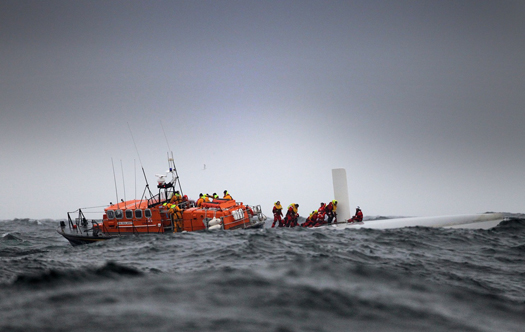
Rambler 100s upside down hull was hard to spot. Photo: Team Phaedo
For all her great size, the capsized Rambler was remarkably difficult to spot on that grey evening, as her upturned white hull was easily mistaken for a breaking wave.
It sounds like a neat idea, but some agreed definition of boat that is likely to capsize would be a necessary starting point. After all, having a dayglo orange bottom will amount to a statement that your boat is pushing the envelope of lightness and exceptional ballast leverage to the absolute limit, upon which all old salts will say that it's damned unseamanlike, and shouldn't be permitted out of the harbour in the first place.
Then too, which particular shade of dayglo would sir or madam prefer? While extremely useful and indisputably life-saving, when considered purely as colours they're all horrible - in fact, the more horrible, the more effective they become.
Time was when all sorts of notions attached to the different colours of anti-fouling bottom paint, and as most of them change in shade as the season progresses, all sorts of debates are possible on which is the more effective, and at what time in the year.
In the old days, the feeling was that only red anti-fouling was effective – it was something to do with the lethal chemicals which could be successfully incorporated in red. Black was also supposed to be okay, but not blue, and – surprisingly – not brown, despite its relative closeness to clean copper. But of course green like weathered copper was and is much approved – it's what I use myself, but it has to be admitted that's mainly because I simply like the look of it.
One colour which used to be regarded as wellnigh impossible was white, which made it a challenge for amateur chemists. Back in the day when boats were still kept in Ballyholme Bay, I can remember as a kid that the annual launch of the little keelboats of the Bay Class used to see the slipway area kept clear for one boat which would arrive without the anti-fouling already applied. She would be set up ready for launching at the top of the slip, and then the owner would arrive at high speed on his bike, with the carrier loaded with cans of white anti-fouling to his own recipe which he'd been mixing at home in the kitchen, This anti-fouling would be applied in jig time, and the boat then was hurled down the slip into the water, as the magic brew was supposed to lose its potency in fresh air even more quickly than standard anti-foulings.
It looked very smart - white topsides, red boot-top, and white bottom – but the boring boats with the red anti-fouling were always winning by mid-season. But then, in those days antibiotics weren't part of everyday life. Today you'd be regarded as anti-social and an ecological hooligan if you put veterinary anti-biotics into your anti-fouling, but it works.
And I'm told essence of horseradish works quite well too. But this seems to be taking us away from the subject of the colour of boats' bottoms for safety purposes. So maybe we should be talking with our neighbourhood whales. Seafaring lore would have it that whales tend to attack boats with white or red bottoms, but will leave blue, black or green alone. So what are whales likely to make of the heroically revolting dayglo lime, let alone the standard dayglo orange?
UCD Crowned Student Yachting World Champions in France
#sywoc – Ireland's UCD sailing team have beaten Canada by 12 points to win the Student Yachting World Cup in France after the series was shortened due to gales in La Rochelle. The Irish team took the lead on Tuesday and extended it after being reinstated in a race they were previously disqualified from.
The event had been decided on the results of 13 races and two discards. IRL were clear winners on 25 points from Dalhousie University on 37 points and Italy's CUS Brescia in third place on 41 points. 14 Teams competed. (See full results sheet for download below).
It is the second time Ireland has won the prestigious trophy, Cork Institute of Technology won in 2008.
The Irish team claimed victory by the largest margin ever recorded by an Irish team competing throughout the 32 year history of the event. Team Ireland dominated the regatta by consistently scoring podium places in almost all of their 13 races throughout the championship to finish on a total of 25 points while their closest rivals, Team Canada, finished on 37 points.
The regatta which was held in La Rochelle, France, saw the top 14 teams from around the world compete for six days in wide ranging sailing conditions and race course formats. Team Ireland set down a clear marker of their intentions on the first day of the regatta by carding two second places. Team Ireland took a little longer to find their groove on the inshore race course however carding an eighth place, leaving them in third place overall on the first evening.
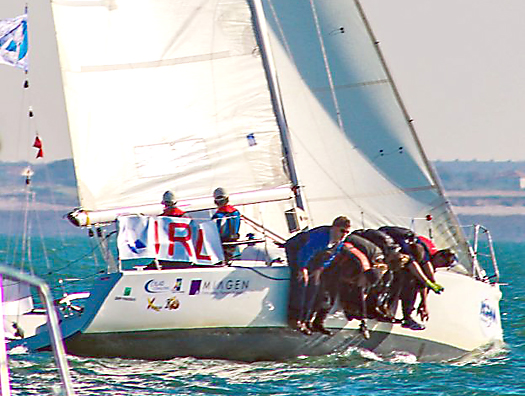
UCD hike hard on their way to a World tite win in La Rochelle
From there, the team's ability and confidence improved as they learned how to sail the boat most effectively in the varying wind and wavy conditions that La Rochelle produced on a daily basis. Team skipper Aidan Mc Laverty produced some breath-taking start line manoeuvres when jostling with the other nations trying to ensure the team started at the most favourable end of the start line on each occasion. Team Ireland's tactician Barry Mc Cartin's research on wind and tides in La Rochelle paid dividends as he frequently called the best lines and angles to sail the team around the course.
Day two of the regatta brought similar sailing conditions with a short chop and 12 knots of breeze. Team Ireland carded once again two second place finishes and an unfortunate "Did Not Finish" in the inshore race due to a navigational error. It was at this stage in the regatta where Team Ireland's training began to show as sail trimmers Simon Doran and Cathal Leigh-Doyle ensured the team maintained the best boat speed in the fleet.
The regatta brought numerous twists and turns on day three as the team carded a third place finish followed by two first place finishes in race numbers 8 and 9. The team utilised their subs tactically by brining on Ben Fusco and Ellen Cahill for the night race. This six hour long race was started at 16.30 and provided a unique tactical challenge to the team who had to cope with pitch black darkness as they sailed around La Rochelle bay. The team fought extremely hard in the testing conditions and finished third only securing their place on the last 20 meters of the race. Team Ireland's pit crew member Alyson Rumball, played a crucially influential role in ensuring our sail changes went smoothly and quickly throughout the night.
Going into the final three days of the regatta, Team Ireland had the smallest of cushions over second place Team Canada. Team fitness allowed the team to push on in the increased winds. Team mast man Theo Murphy and bowman David Fitzgerald excelled in the conditions and allowed them to out manoeuvre the other teams downwind while Bella Morehead trimmed brilliantly downwind.
Unfortunately, the last two days of the regatta had to be cancelled due to winds gusting 40 knots on the race course. However, Team Ireland's lead of 12 points ensured they secured the prestigious trophy and won the regatta. As a result of their win, Ireland Sailing Team –UCD will return to defend their title next year in France.
The team have to thank everyone for their support in the lead up and during the event. Support from Ireland and across the world during the regatta has been amazing and kept the team motivated and focused on representing our country.
Video Evidence Reinstates UCD as Irish Lead at Student Yachting Cup
#sywoc – UCD sailing team extended their overall lead at the Student world Yachting Cup in La Rochelle France yesterday after producing video evidence to prove they should not have been disqualified from Tuesday's racing for a premature start rule infringement.
Overturning the decision means the UCD team now lead the world championships by 11 points overall.
According to team captain Cathal Leigh Doyle UCD discovered a video of the start oin question that showed UCD acutally under the line when the start flag was dropped!
There are only two races left to sail in the series and sailing is called off todaywith 27-33 knots. The forecast for tomorrow is similar or worse. The latest they can start a race is 1.30 tomorrrow.




























